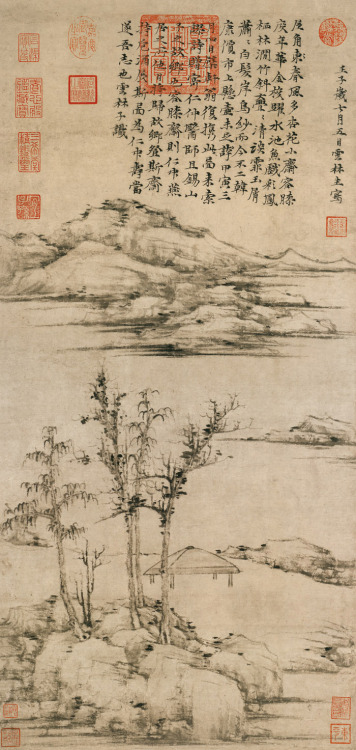#chinese calligraphy
Ni Zan, Rongxi Studio, 1372, ink on paper.
Ni Zan (1301-1374) is considered to be one of the four great masters of the Yuan Dynasty (1279-1368). Despite this his output as an artist was very limited and he chose similar motifs for each piece, making him in a sense the original Chinese series painter. His work often included mountains, shelter, trees and water but executed in a sparing style which boarded on offhanded, however his sparse technique somehow exudes a wistful atmosphere which is unique in itself.
As well as this Ni Zan was one of the pioneers in the concept of the three perfections, poetry, calligraphy and painting. Promoting the idea that a picture inscribed with a poem written in a complementary calligraphic style enhances the aesthetic accomplishment of the piece.
Post link
حاجي نور米广江(Haji Noor Deen Mi Guangjiang) -رحمان (Rahman - All Beneficent, the Magnanimous One; one of the 99 names of Allah) - 2006
Post link
A Corner of Ling Yan Jian (霝岩澗一角). Pan Tianshou (潘天壽). Colour on paper. 1955.
Pan Tianshou (1897–1971) was a Chinese painter and educator. He attended Zhejiang First Normal School, and studied Chinese traditional painting under famous artist Wu Changshuo (吳昌碩). Pan was among those persecuted during the Cultural Revolution.
A Corner of Ling Yan Jian, like most of Pan’s works, is a bird and flower painting (花鳥畫) done with the freehand brush work style (寫意). However, the piece stands out among other paintings in the same category in that it combines the flowers with the landscape.
Follow sinθ magazine for more daily posts about Sino arts and culture.
Post link
Mào Xiāng ranks among the most colorful characters in 17th-century China. Perhaps best known today as a poet and romantic, Mào also enjoyed considerable fame as a calligrapher during his own lifetime. He was a disciple of one of the most important calligraphers and painters of his age, Dǒng Qíchāng 董其昌(1555–1636).
The text of the calligraphy, recounting a visit to West Lake near the city of Hangzhou, is a well-known vignette from a travelogue by poet and essayist Yuán Hóngdào 袁宏道 (1568–1610). Yuán was a central figure in a group of late Ming writers and poets who believed that good writing originated from genuine feeling and authentic experience, rather than from strict imitation of traditional literary models. Throughout his short life, Yuán sought to balance tradition and innovation and to keep his perception of the world fresh. Although he died a year before Mào was born, the younger man undoubtedly became familiar with Yuán’s philosophy of life through their mutual friend, Dǒng Qíchāng. Mào’s choice of this text is an interchange both with Yuán (in part because he was also a bon vivant) and with his teacher, Dǒng, whose style of calligraphy Mào strongly alludes to in this scroll.
Now on view in the exhibition Conversations: Past and Present in Asia and America.
Image:
Mào Xiāng 冒襄(Chinese, 1611–1693)
Waiting for the Moon at Six Bridges, 17th century
Handscroll, ink on satin
Overall: 14 3/16 x 218 ½ in. (36 x 555 cm)
General Acquisitions Fund, 1970.39
Post link
Fuck your dream job what’s your dream hobby that you don’t have the means to take up yet. Mine are falconry and aerial acrobatics




